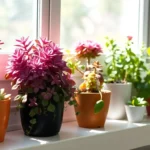Tired of watching your beautiful plants fall victim to hungry pests? We’ve all been there – discovering chewed leaves, aphid colonies, or spider mite damage that makes our gardening hearts sink. While commercial pesticides might seem like the quick fix, they often come with harsh chemicals that can harm beneficial insects, contaminate soil, and pose risks to our families and pets.
That’s where natural bug spray answers become game-changers for conscious gardeners. We’re talking about powerful, eco-friendly alternatives that actually work – without the toxic side effects. These homemade remedies use common household ingredients like soap, oils, and herbs to create effective barriers against destructive insects.
The best part? Natural bug sprays are incredibly cost-effective and easy to make. We’ll show you how to protect your plants using ingredients you probably already have in your kitchen, giving you peace of mind while keeping your garden thriving naturally.
Understanding Natural Bug Spray for Plants and Its Benefits
Natural bug sprays offer gardeners a safer alternative to harsh chemicals while effectively protecting plants from common pests. We can create these eco-friendly answers using simple ingredients that won’t compromise our garden’s health or our family’s wellbeing.
Why Chemical Pesticides Can Harm Your Garden
Chemical pesticides disrupt the natural network balance that keeps gardens healthy and thriving. We see synthetic chemicals kill beneficial insects like ladybugs, lacewings, and predatory wasps that naturally control pest populations. These helpful insects often take longer to recover than the pests they control, creating a cycle where gardens become more vulnerable to infestations.
Soil health suffers significantly when we repeatedly apply chemical pesticides to our plants. Research shows that synthetic pesticides can reduce soil microbial diversity by up to 40%, weakening the foundation that supports plant growth. Our plants become dependent on chemical inputs as their natural defense mechanisms weaken over time.
Residue buildup creates another serious concern for gardeners who grow edible plants. Chemical pesticides can persist in soil for months or even years, potentially contaminating fruits and vegetables we bring to our tables. We put our families at risk when these toxic substances accumulate in the food chain.
Environmental Advantages of Natural Answers
Natural bug sprays protect pollinators and beneficial insects that commercial agriculture desperately needs to survive. We preserve bee populations, butterfly habitats, and other crucial pollinators when we choose plant-based pest control methods. These natural answers break down quickly in the environment without leaving harmful residues.
Water systems remain clean when we use homemade bug sprays made from soap, oils, and plant extracts. Chemical runoff from synthetic pesticides contaminates groundwater and streams, affecting wildlife and drinking water sources. Our natural alternatives dissolve harmlessly without poisoning aquatic ecosystems.
Biodiversity flourishes in gardens treated with natural pest control methods rather than synthetic chemicals. We encourage healthy populations of birds, beneficial insects, and soil organisms that create resilient garden ecosystems. This natural balance helps prevent pest outbreaks more effectively than chemicals alone.
Cost-Effectiveness of Homemade Bug Sprays
Homemade natural bug sprays cost significantly less than commercial pesticides while providing comparable pest control results. We can create effective answers for under $2 per gallon using common household ingredients like dish soap, vegetable oil, and baking soda. Commercial organic pesticides often cost $15 to $30 per bottle for similar quantities.
Basic ingredients for natural bug sprays serve multiple purposes beyond pest control in most households. We already stock items like liquid soap, cooking oils, and essential oils for other uses, making the actual cost per application minimal. These multipurpose ingredients provide better value than single-use chemical products.
Storage and shelf life advantages make homemade answers more economical over time than store-bought alternatives. We can mix fresh batches as needed rather than purchasing products that lose effectiveness or expire before we use them completely. This approach eliminates waste while ensuring maximum potency for each application.
Essential Oil-Based Natural Bug Spray for Plants
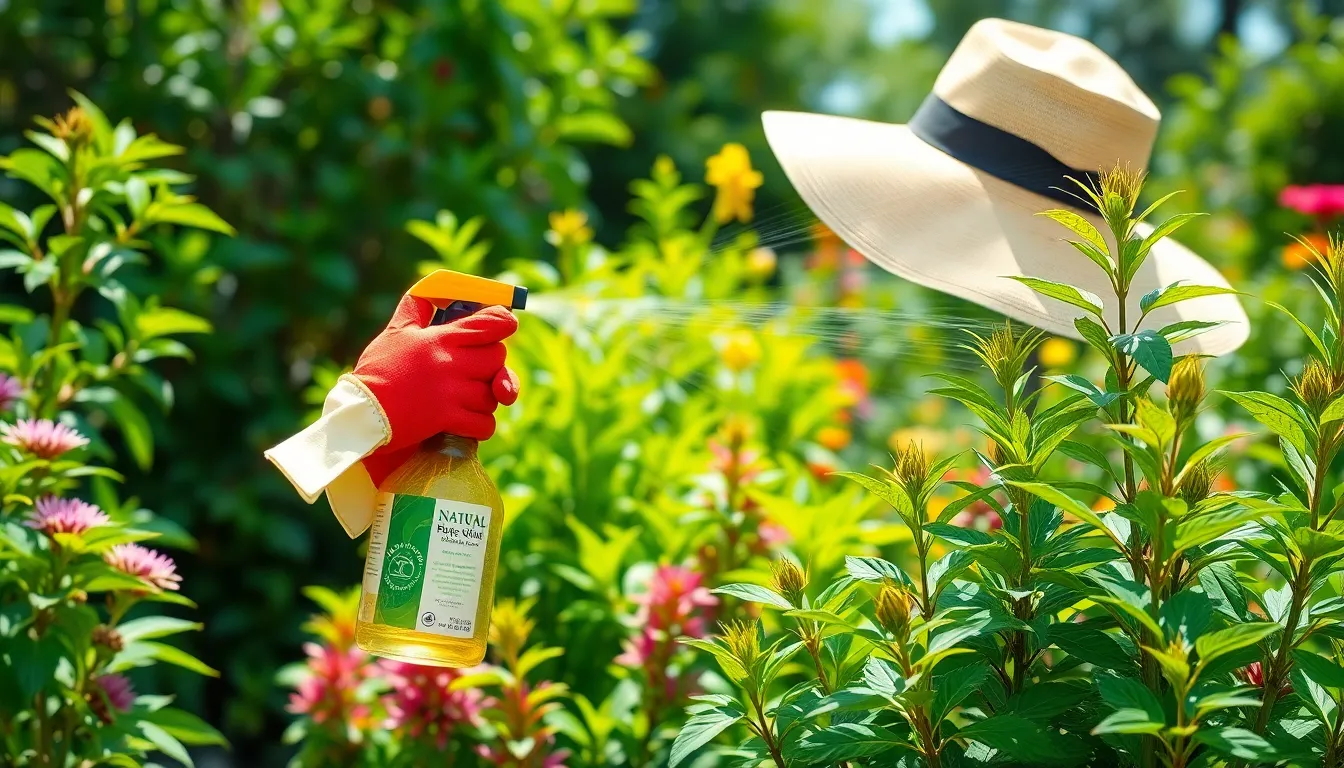
Essential oils transform ordinary water into powerful pest deterrents that protect our plants without harming beneficial insects or our families. We’ve discovered that these concentrated plant extracts work by disrupting pest biological systems while masking the scents that attract unwanted insects to our gardens.
Neem Oil Spray Recipe and Application
Neem oil disrupts insect life cycles by acting as an antifeedant, repellent, and growth inhibitor all in one formula. We recommend mixing 2 tablespoons of neem oil with 1 gallon of water plus 1 teaspoon of mild liquid soap to create an effective spray that targets aphids, whiteflies, and spider mites.
Application timing matters significantly with neem oil treatments. We apply this mixture during early morning or late evening hours to prevent leaf burn from sun exposure. Shake the container thoroughly before each use since oil and water naturally separate.
Coverage should include both tops and undersides of leaves where pests often hide. We’ve found that weekly applications provide the best protection, though heavily infested plants may need treatment every 3-4 days initially.
Peppermint Oil Deterrent Formula
Peppermint essential oil creates a powerful barrier that masks plant odors and irritates insects on contact. Our go-to recipe combines 10-15 drops of peppermint oil with 1 cup of water and 1 tablespoon of mild liquid soap or witch hazel as an emulsifier.
Strong scent intensity makes this formula particularly effective against mosquitoes, ants, and various garden pests. We shake the mixture vigorously before application since essential oils don’t naturally dissolve in water.
Direct spraying onto affected plant areas provides immediate protection. We target areas where we’ve noticed pest activity, paying special attention to new growth and flower buds that attract insects.
Reapplication becomes necessary after rain or heavy watering since the oils wash away easily. We typically reapply every 3-5 days during peak pest season for consistent protection.
Eucalyptus and Tea Tree Oil Combinations
Combining eucalyptus and tea tree oils leverages their complementary insect repellent properties for broader pest control. We mix 10-20 drops of each oil with 2 cups of water and a small amount of liquid soap to create this dual action spray.
Antimicrobial effects from this combination protect plants from both insects and certain fungal pathogens. We’ve observed that this mixture effectively deters aphids, mites, and flying insects while supporting overall plant health.
Versatility makes this combination suitable for most garden plants, though we always test on a small area first. We spray during cooler parts of the day to maximize effectiveness and prevent any potential leaf sensitivity.
Storage life extends up to one week when kept in a cool, dark place. We prepare fresh batches regularly since essential oils lose potency over time and provide the best results when used fresh.
Soap-Based Natural Bug Spray Solutions
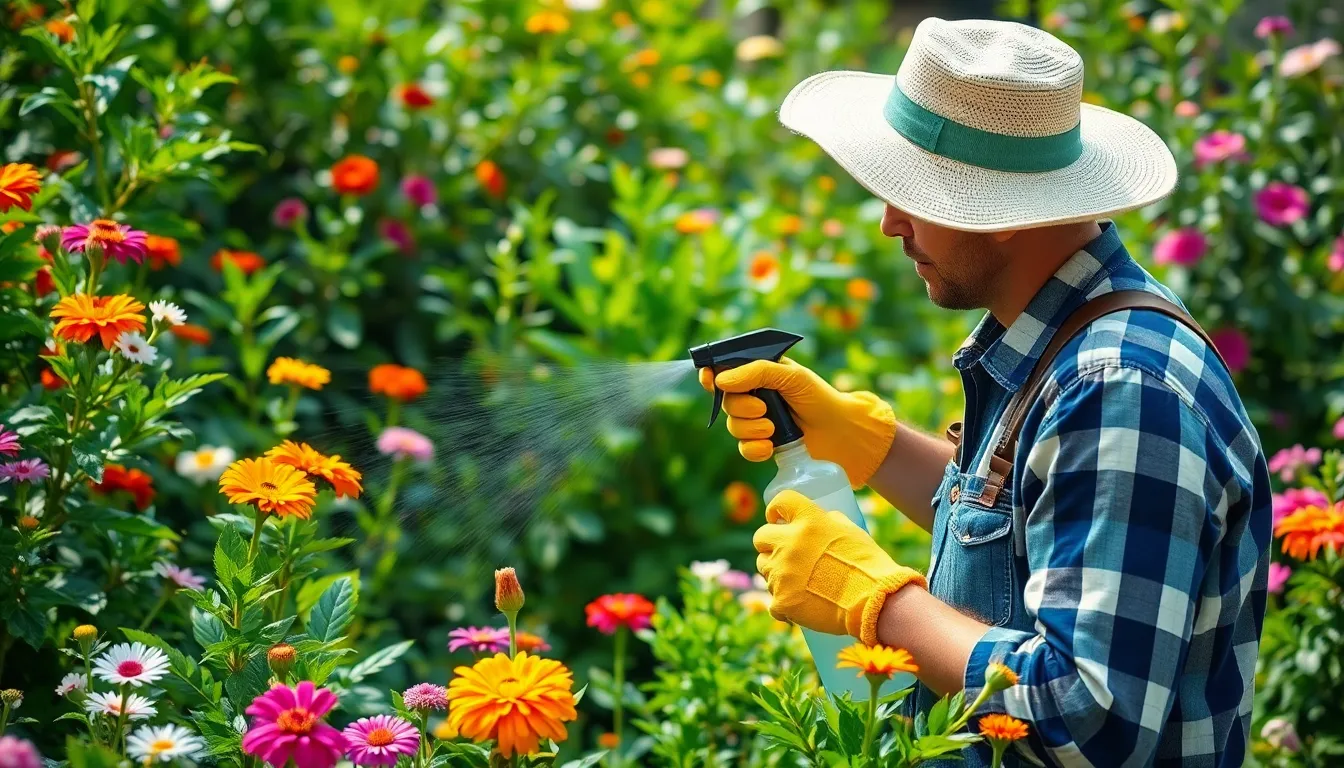
Soap-based sprays offer one of the most reliable and gentle approaches to natural pest control. These answers work by disrupting insect cell membranes and causing dehydration without harming your plants.
Dish Soap and Water Mixture
Dish soap creates an effective foundation for homemade pest control when mixed with water at the right concentration. We recommend combining one to two teaspoons of mild dish soap per quart of water for optimal results. This simple mixture targets common garden pests like aphids, spider mites, and whiteflies by suffocating them and breaking down their protective coatings.
Application requires spraying the solution directly onto affected plants, focusing on areas where pests congregate. Testing the mixture on a small plant section first helps ensure your exact plants won’t experience sensitivity reactions. The gentle nature of this soap solution makes it safe for regular use throughout the growing season.
Castile Soap Bug Spray Recipe
Castile soap provides a superior alternative to conventional dish soap because it’s made from organic vegetable oils and biodegradable ingredients. Our preferred recipe combines one tablespoon of Dr. Bronner’s Castile soap with one quart of water for maximum effectiveness.
Thorough application involves spraying the mixture on plant stems and leaf undersides where pests typically hide. Early morning or evening applications work best since they prevent rapid evaporation and allow the solution more time to work. This organic approach proves safer for humans while remaining less harmful to beneficial insects like bees and ladybugs when applied carefully.
Adding Essential Oils to Soap Sprays
Essential oils enhance soap-based sprays by providing additional insect-repelling properties through natural plant compounds. Research shows that peppermint, citrus, lemon eucalyptus, garlic, and chili pepper extracts effectively deter various pests through their strong aromatic properties.
Peppermint or citrus oils work well when added in small quantities to existing soap answers for improved bug-repellent action. Lemon eucalyptus oil offers commercial-grade effectiveness but differs chemically from regular lemon oil, so proper identification matters. Garlic and chili pepper extracts provide powerful deterrent effects due to their intense aromas that naturally repel insects.
Careful dosing prevents plant damage since only a few drops of essential oil should be combined with each soap solution. This balanced approach maximizes pest control while protecting your plants from potential phytotoxicity.
Garlic and Onion Natural Bug Spray for Plants
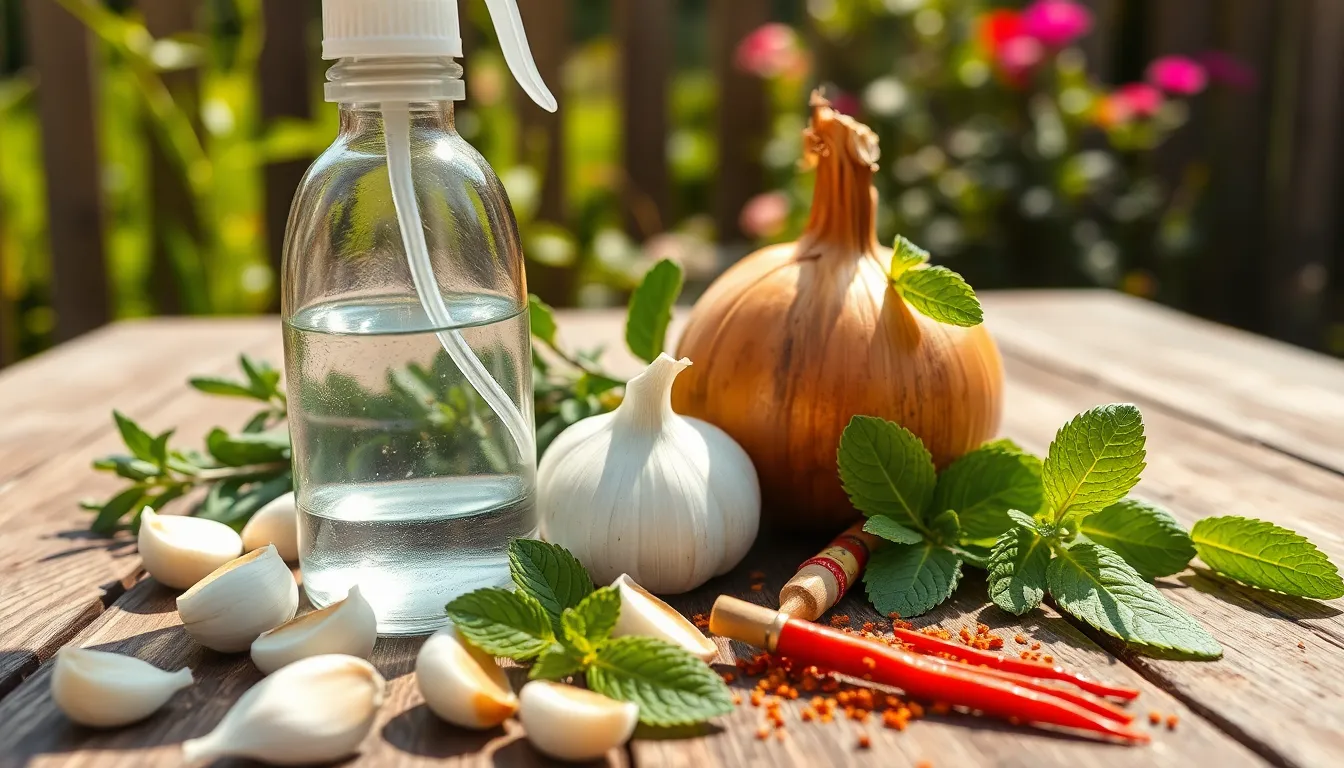
Moving beyond oils and soaps, garlic and onion create powerful natural deterrents that leverage their strong aromatic compounds to repel garden pests effectively.
Garlic Spray Preparation Method
Creating a basic garlic spray starts with gathering 4 to 5 garlic cloves and natural dish soap. Crush the garlic cloves using a garlic press or food processor to release their potent sulfur compounds. Combine the crushed garlic with water and add a few drops of biodegradable dish soap to help the mixture stick to plant surfaces.
Steeping the mixture overnight allows the garlic’s natural oils to infuse into the water completely. Strain out all solid pieces using cheesecloth or a fine mesh strainer before transferring to your spray bottle. This prevents clogging and ensures smooth application.
Improving effectiveness becomes possible by adding eucalyptus or tea tree oil mixed with sunflower oil at a 1:10 ratio. These essential oils complement garlic’s natural pest-repelling properties while providing additional protection against various insects.
Onion-Based Pest Deterrent Recipe
Preparing onion spray requires one medium onion (or an entire head for stronger concentration) plus natural dish soap. Chop the onion finely to maximize surface area and release more pest-deterring compounds during the cooking process.
Simmering the mixture for 45 to 60 minutes extracts the onion’s sulfur compounds that insects find repulsive. Keep the heat gentle to avoid destroying beneficial compounds while ensuring proper extraction.
Straining and finishing the cooled mixture through cheesecloth removes all solid particles. Add biodegradable dish soap before transferring to your spray bottle, then apply to pest-affected plants weekly or after rainfall for continued protection.
Combining Garlic and Onion for Maximum Effect
Maximizing pest control happens when we blend garlic and onion with complementary natural ingredients. This powerful combination includes:
| Ingredient | Amount | Purpose |
|---|---|---|
| Medium onion | 1 | Sulfur compound base |
| Garlic cloves | 4 | Enhanced repellent action |
| Mint leaves | 2 cups | Additional deterrent |
| Cayenne pepper | 2 tablespoons | Heat-based repellent |
| Castile soap | 2 tablespoons | Adherence booster |
| Water | To make 1 gallon | Final dilution |
Blending the ingredients creates a comprehensive pest deterrent that targets multiple insect types. Process garlic, onion, mint, and cayenne pepper together, then allow the mixture to steep for several hours before straining through fine mesh.
Application timing matters significantly for preventing leaf burn and maximizing effectiveness. Spray affected plants once or twice weekly during evening hours when temperatures are cooler. Reapply after heavy rains to maintain protection levels throughout the growing season.
Vinegar-Based Natural Bug Spray Formulas
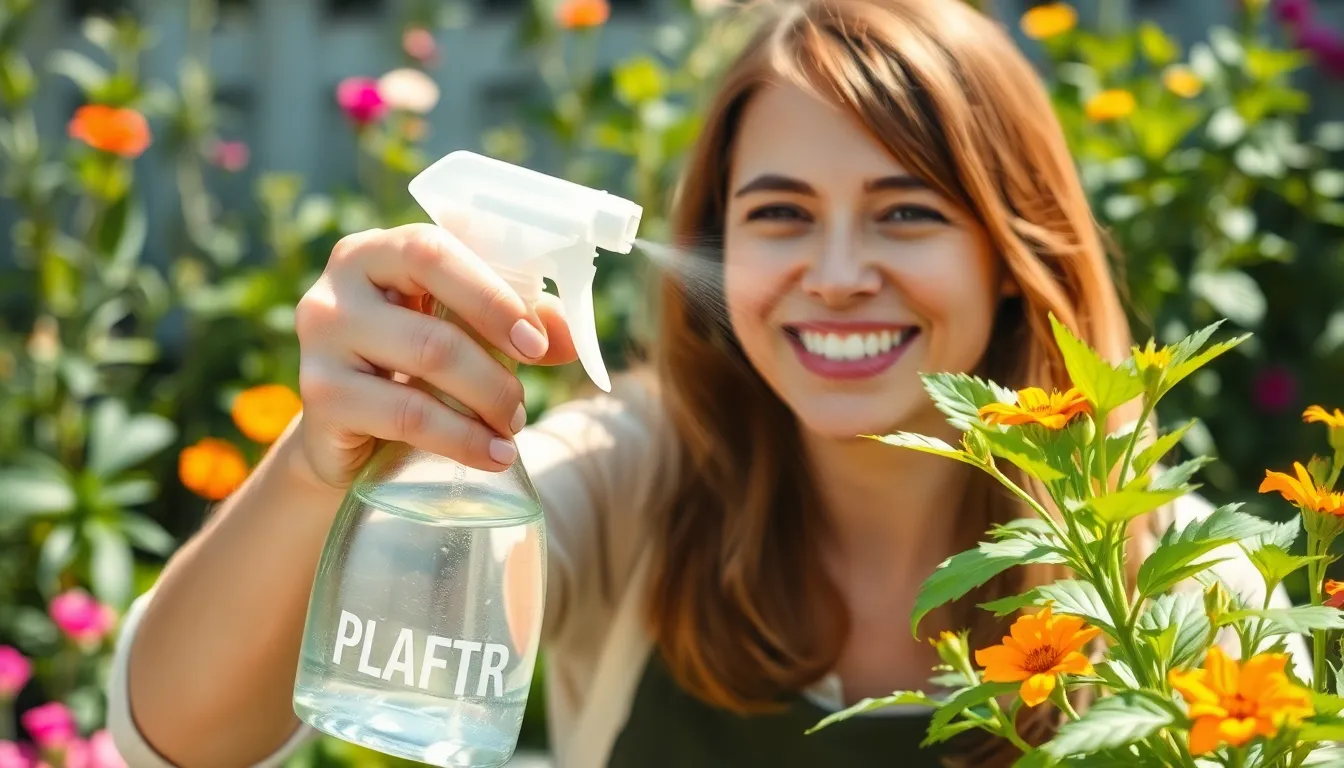
Vinegar offers gardeners another powerful natural weapon against plant pests. This acidic household staple creates an environment that insects find inhospitable while remaining safe for plants when properly diluted.
Apple Cider Vinegar Spray Recipe
Apple cider vinegar’s natural acidity makes it an excellent pest deterrent for common garden invaders. We recommend mixing one part apple cider vinegar with three parts water to create an effective base solution.
Adding a few drops of biodegradable dish soap helps the mixture stick to plant surfaces longer. This combination effectively deters aphids, whiteflies, and other soft bodied insects that damage leaves and stems.
Spray this solution directly onto affected areas during cooler morning or evening hours. The acidic properties repel pests without harming beneficial insects when applied correctly.
White Vinegar Plant Protection Solution
White vinegar provides similar pest control benefits through its acidic composition. Mix one tablespoon of white vinegar into one quart of water for a gentle yet effective formula.
This diluted solution works particularly well on established plants with tougher foliage. We suggest testing the mixture on a small leaf section first before treating delicate or young plants.
Regular applications create an unwelcoming environment for insects while maintaining plant health. The formula’s simplicity makes it perfect for quick treatments when pests first appear.
Adding Herbs to Vinegar Sprays
Infusing herbs into vinegar sprays dramatically increases their pest fighting power. Rosemary, mint, basil, lavender, and garlic all contain natural compounds that insects avoid.
Create herb infused vinegar by boiling rosemary in water or soaking minced garlic in vinegar for several hours. Mint leaves can be steeped directly in the vinegar solution to release their aromatic oils.
Strain the mixture thoroughly before adding water and soap, then apply to plants as needed. These enhanced formulas not only repel insects but can also eliminate pests on contact through their concentrated aromatic compounds.
Baking Soda Natural Bug Spray Options

Baking soda offers gardeners another powerful weapon in their natural pest control arsenal. This common household ingredient works primarily as a fungicide while providing mild insect repelling properties.
Basic Baking Soda Spray Formula
Creating your first baking soda spray requires just a few simple ingredients we likely have in our kitchen cabinets. Mix 1 tablespoon of baking soda with 1 gallon of water to create the foundation of this natural plant protector. Adding 1 teaspoon of liquid soap like castile soap helps the solution stick better to plant surfaces and increases its effectiveness.
Testing the spray on a small area first ensures our plants won’t experience any adverse reactions. Apply this mixture using a spray bottle during cooler parts of the day to prevent leaf burn. Reapplication every 7 to 14 days maintains consistent protection against fungal diseases.
Combining Baking Soda with Oil
Improving baking soda sprays with natural oils creates a dual action formula that fights both fungal pathogens and insect pests. Neem oil combined with baking soda and liquid soap in water targets a broad spectrum of garden threats without harming beneficial insects. This combination gives us the fungus fighting power of baking soda plus the pest control benefits of oil.
Vegetable oil serves as another excellent addition to baking soda sprays for gardeners seeking kitchen cabinet answers. The oil component suffocates soft bodied insects like aphids and spider mites while the baking soda prevents fungal growth. Mixing these ingredients creates a cost effective spray that addresses multiple plant health issues simultaneously.
Targeting Exact Plant Diseases
Powdery mildew responds particularly well to baking soda treatments because the sodium bicarbonate alters pH levels on leaf surfaces. Regular application creates an environment hostile to fungal spores and prevents new outbreaks from establishing. We’ll see the best results when we start treatment at the first signs of white powdery patches on leaves.
Other fungal diseases like black spot and downy mildew also benefit from baking soda applications, though the results may be more gradual. Repeated treatments help reduce existing infections and create protective barriers against future outbreaks. Severe infestations might require stronger natural alternatives like neem oil for complete control.
Insect pest management improves significantly when we combine baking soda with companion ingredients like garlic or essential oils. Baking soda alone provides minimal insect repelling effects, but these combinations create more comprehensive pest deterrent answers. This approach allows us to address both fungal and insect problems with a single treatment application.
Cayenne Pepper and Spice-Based Sprays
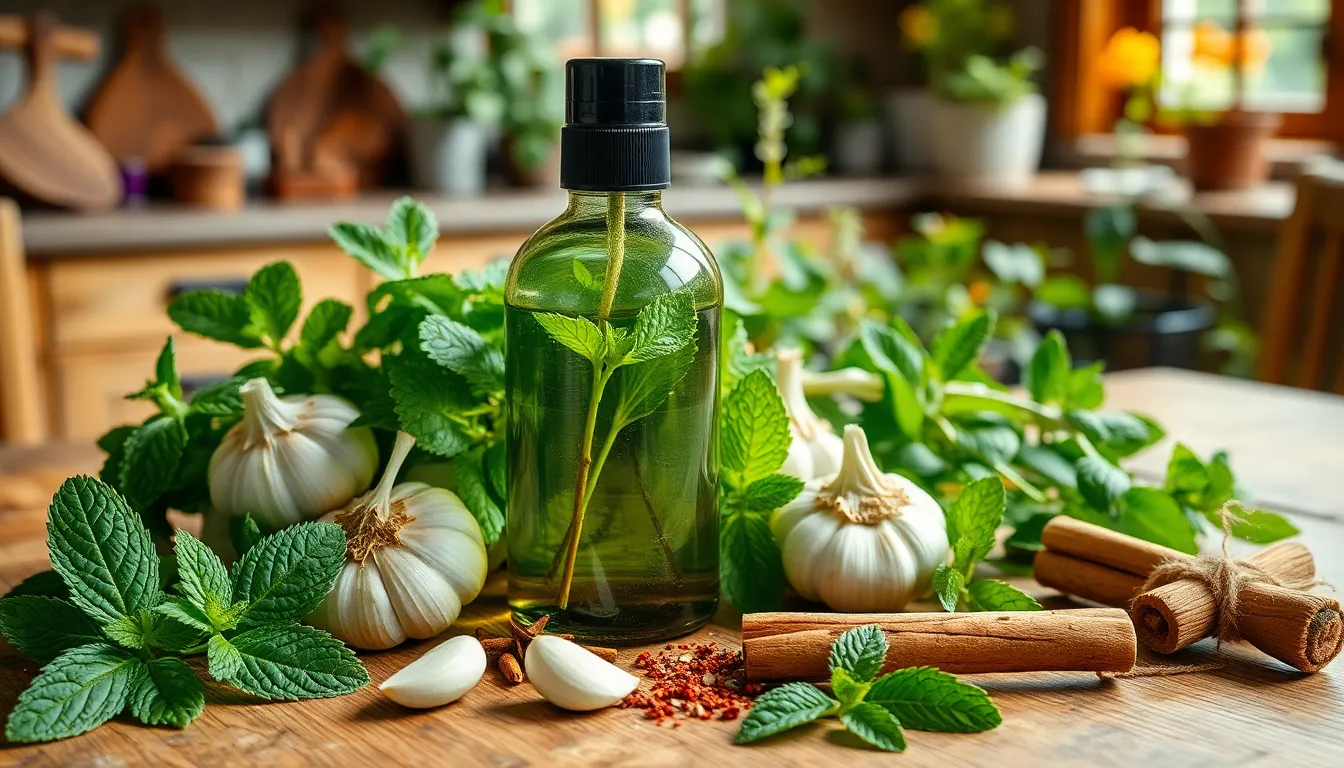
Building on natural pest control methods, we can harness the power of kitchen spices to create effective bug deterrents. Spice-based sprays work by overwhelming pests with strong scents and compounds that irritate their sensory systems.
Hot Pepper Spray Recipe
Hot pepper spray delivers powerful pest control using capsaicin compounds that repel and deter unwanted insects. We’ll create this effective formula using readily available ingredients that pack a punch against garden pests.
Ingredients needed:
- 2 heads of garlic (cloves separated and peeled)
- 3 cups of mint leaves and stems
- 2 teaspoons of dry cayenne pepper
- 12 cups of water
- 2 small squirts of biodegradable dish soap
Preparation steps:
- Pulse garlic and mint in a food processor until finely chopped
- Transfer the mixture to a large pot and add cayenne pepper and water
- Bring the solution to a boil then let it sit overnight to maximize strength
- Strain the liquid into spray bottles and add biodegradable dish soap
- Spray affected plants thoroughly covering both sides of leaves
Refrigeration extends this spray’s shelf life up to one month, though we recommend using it within this timeframe for maximum potency. Shake the bottle well before each application to ensure proper ingredient distribution.
Cinnamon and Clove Combinations
Cinnamon and clove create aromatic barriers that pests find overwhelming due to their antimicrobial properties and intense scents. We can prepare these spice combinations using similar boiling methods to extract their pest-fighting compounds.
Basic spice infusion method:
- Combine 2 tablespoons of ground cinnamon with 1 tablespoon of ground cloves
- Boil the spices in 4 cups of water for 15 minutes
- Allow the mixture to cool and steep for several hours
- Strain the liquid and transfer to spray bottles
These aromatic compounds work particularly well against soft-bodied insects like aphids and spider mites. Essential oils from these spices create an invisible protective layer that deters pests from settling on treated plants.
Safety Precautions When Using Spice Sprays
Safety considerations ensure we protect our plants while maximizing the effectiveness of spice-based treatments. Timing and application methods play crucial roles in preventing plant damage.
Application timing guidelines:
- Apply sprays on cloudy days to prevent leaf burn from sun exposure
- Target early morning or evening hours when temperatures are cooler
- Avoid spraying during peak sunlight hours between 10 AM and 4 PM
Plant protection measures:
- Test spray on a small plant section first to check for adverse reactions
- Monitor sensitive plants like seedlings and delicate flowers more closely
- Avoid overuse as high spice concentrations might harm vulnerable plant tissues
Storage and handling tips:
- Store prepared sprays in cool locations or refrigerate for extended shelf life
- Use sprays within one month for optimal pest-fighting effectiveness
- Shake bottles thoroughly before each use to maintain proper ingredient mixing
Proper preparation and application timing maximize these natural bug sprays’ benefits while minimizing risks to our garden plants.
Herb-Infused Natural Bug Spray for Plants

We can transform our kitchen herbs into powerful pest deterrents using their natural pest-repelling properties. Many herbs produce essential oils with compounds that repel pests by disrupting their sensory receptors, offering a safer alternative to chemical pesticides while supporting both pest control and environmental health.
Basil and Mint Spray Answers
Basil’s aromatic compounds confuse harmful insects by interfering with their ability to locate host plants. We steep fresh basil leaves in boiling water for 15-20 minutes to extract these powerful oils. The cooled and strained mixture creates an effective spray that targets common garden pests without harming beneficial pollinators.
Mint’s strong aroma deters ants, aphids, and flea beetles through its potent essential oils. Creating mint spray follows the same steeping process as basil, requiring fresh leaves and hot water for optimal extraction. We pour the finished solution into spray bottles and apply directly to plant leaves and stems every few days or after rainfall.
Both basil and mint sprays work by overwhelming pest sensory systems rather than poisoning them. This approach protects our plants while maintaining garden network balance. Regular application ensures continuous protection throughout the growing season.
Rosemary and Thyme Pest Deterrents
Rosemary contains volatile compounds like camphor that effectively repel mosquitoes, aphids, and whiteflies. We brew rosemary tea using the same hot water steeping method, allowing the herbs to release their natural deterrent oils. The resulting spray provides dual benefits of pest control and antifungal properties for improved plant health.
Thyme’s high concentration of thymol makes it particularly effective against soft-bodied insects and flying pests. Preparing thyme spray requires steeping fresh or dried thyme in hot water until the liquid develops a strong herbal scent. We strain the cooled liquid and transfer it to spray bottles for easy garden application.
These Mediterranean herbs offer longer-lasting protection compared to other natural remedies due to their concentrated essential oil content. Regular application every 3-5 days maintains effective pest barriers around vulnerable plants. Both rosemary and thyme sprays can be combined for enhanced pest-fighting power.
Creating Herb Tea Sprays
Herb tea sprays harness natural plant defenses through a simple brewing process that requires minimal ingredients. We collect fresh herbs like basil, mint, rosemary, or thyme and chop them to release maximum oils during steeping. Boiling water extracts the beneficial compounds over 15-30 minutes of brewing time.
Cooling and straining removes plant debris while preserving the active pest-deterrent compounds in the liquid. We add a few drops of natural liquid soap to help the spray adhere to plant surfaces and improve coverage. This soap addition increases effectiveness without introducing harmful chemicals to our gardens.
Application timing affects spray performance, with early morning or evening treatments providing optimal results. We spray infested plants thoroughly, covering both upper and lower leaf surfaces where pests commonly hide. These sprays interfere with pest sensory receptors and reduce insect feeding and egg-laying behaviors on treated plants.
Fresh herb combinations create more potent deterrents than single-herb answers. We experiment with different ratios to find the most effective blends for exact pest problems in our gardens.
Application Tips for Natural Bug Spray Success
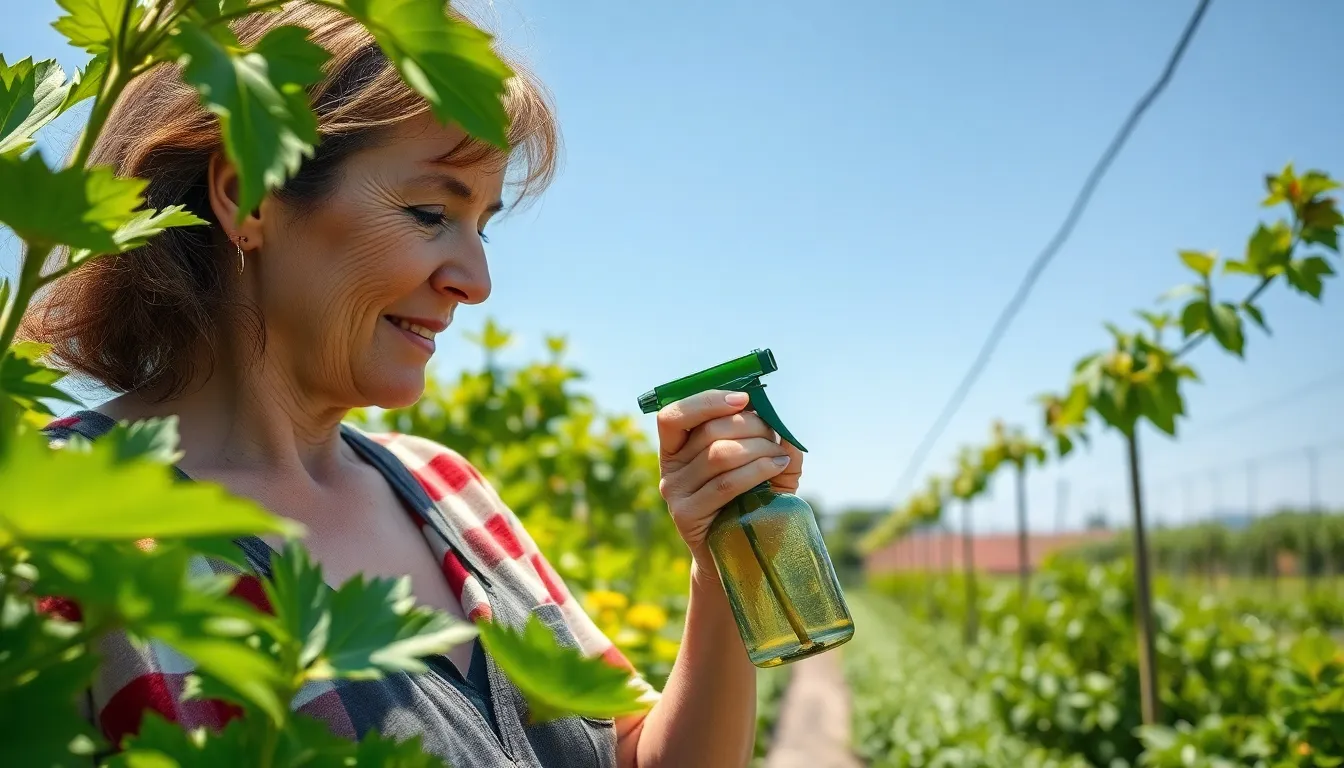
Applying our homemade bug sprays correctly makes the difference between effective pest control and wasted effort. We’ll share the essential techniques that ensure maximum effectiveness while keeping your plants healthy and protected.
Best Times to Apply Natural Sprays
Evening applications provide the most effective results for natural bug spray treatments. We recommend spraying between 6-8 PM when temperatures drop and direct sunlight won’t cause leaf burn from spray interaction. Early morning hours before 10 AM also work well for spray application.
Cloudy days offer ideal conditions for natural pest control treatments throughout the day. We avoid midday applications when intense sunlight can interact with spray ingredients to damage delicate plant tissues. Overcast conditions allow better absorption while minimizing plant stress.
Cool weather periods maximize the effectiveness of our natural spray formulas. We target days when temperatures stay below 85°F to prevent rapid evaporation and ensure ingredients have time to work against pests.
Proper Coverage Techniques
Thorough leaf coverage requires attention to both upper and lower leaf surfaces where pests often hide. We spray the undersides of leaves first since aphids, spider mites, and whiteflies congregate in these protected areas. Complete coverage includes stems, new growth, and all visible plant surfaces.
Shake mixtures well before each application to ensure ingredients blend properly and maintain effectiveness. We use gentle, even strokes with our spray bottles to avoid oversaturating any single area. Super fine mesh strainers help prevent clogging when we prepare our homemade formulas.
Target visible pests directly when we spot infestations during application. We focus extra attention on areas showing damage or pest activity while maintaining overall plant coverage. Garden sprayers provide better distribution for large gardens compared to handheld bottles.
Frequency of Application Guidelines
Weekly applications work best for most natural bug spray formulas during active growing seasons. We apply our garlic mint cayenne spray every 7-14 days or immediately when pest populations increase. Some recipes like our organic onion garlic blend require reapplication 1-2 times per week for optimal results.
Rain reapplication becomes necessary since natural ingredients wash away more easily than synthetic pesticides. We reapply within 24-48 hours after heavy rainfall to maintain protective coverage. Light misting or morning dew typically won’t require immediate reapplication.
Pest pressure monitoring helps us adjust application frequency based on current garden conditions. We increase treatments to every 5-7 days during peak pest seasons or when we notice returning infestations. Early intervention with 1-2 applications often prevents the need for more intensive treatment schedules.
Common Pests Targeted by Natural Bug Sprays
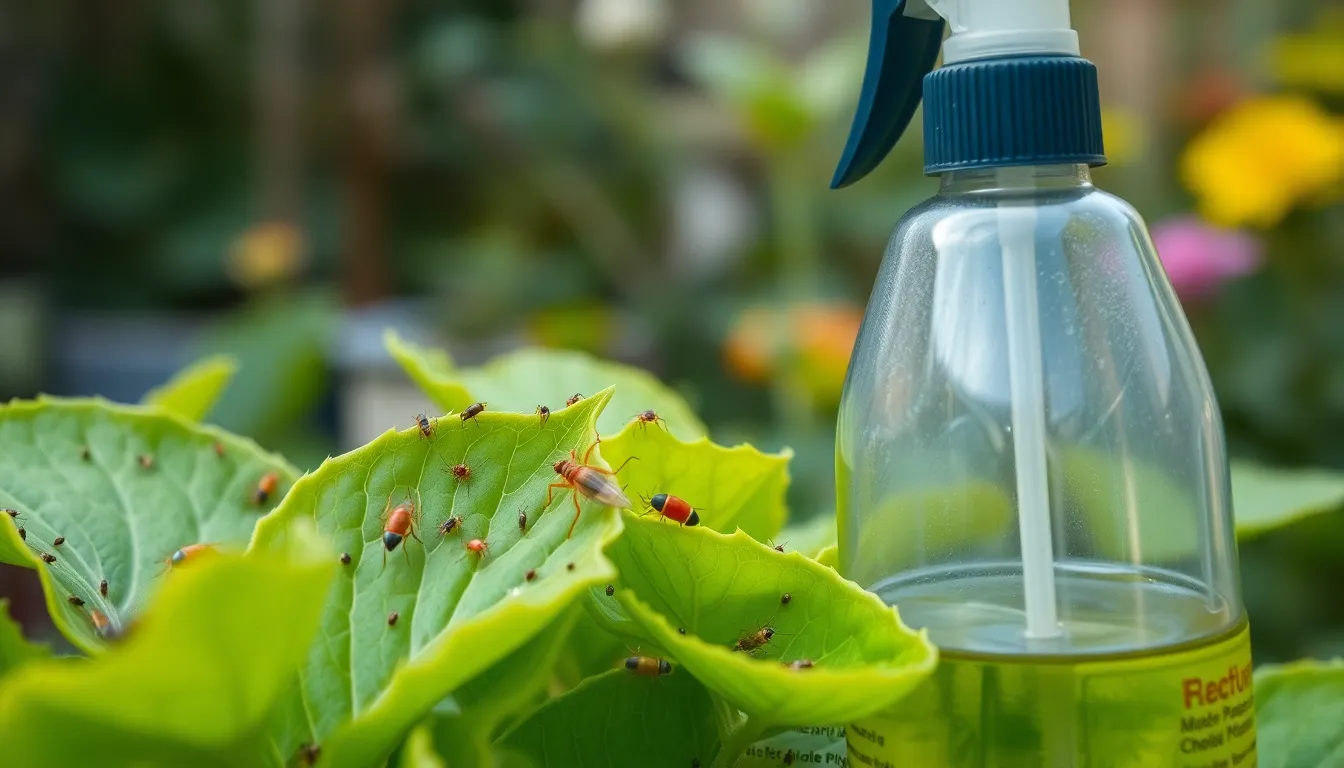
Understanding which pests respond best to natural treatments helps us choose the most effective spray for our exact garden challenges. Different insects have varying vulnerabilities to plant-based answers, making targeted approaches more successful than broad-spectrum treatments.
Aphids and Soft-Bodied Insects
Aphids represent the most vulnerable targets for natural bug sprays, particularly insecticidal soaps and detergent-based answers. These small, soft-bodied arthropods include aphids, young scales, whiteflies, psyllids, mealybugs, and spider mites that succumb easily to natural treatments. Soap-based sprays work by disrupting the insect’s cell membranes, leading to dehydration and death within hours of application.
Natural sprays prove especially effective against these pests because their soft exoskeletons offer little protection against plant-based oils and soap answers. We can target entire colonies of aphids with a single application, as these insects cluster together on new growth and leaf undersides. Essential oil sprays using neem, peppermint, or eucalyptus create an environment that’s hostile to soft-bodied insects while remaining safe for beneficial predators.
Lady beetles and pollinators experience minimal impact from natural bug sprays, making these treatments garden-friendly options. But, beneficial predatory mites can be harmed by soap sprays, potentially disrupting our natural pest control systems if we’re not careful with application timing.
Spider Mites and Whiteflies
Spider mites respond exceptionally well to insecticidal soap treatments due to their microscopic size and delicate body structure. These tiny pests create fine webbing on plant surfaces and cause stippling damage that appears as tiny yellow or white spots on leaves. Whiteflies, another soft-bodied pest, flutter around plants when disturbed and lay eggs on leaf undersides where natural sprays can reach them effectively.
Both pests thrive in hot, dry conditions where they reproduce rapidly, making early intervention with natural sprays crucial for control. We can disrupt their life cycles by applying soap-based answers every 3-5 days during active infestations. Neem oil proves particularly effective against these pests because it interferes with their feeding and reproduction while providing residual protection.
Care must be taken when treating spider mite infestations, as beneficial predatory mites serve as our primary natural defense against these pests. Selective application of natural sprays helps preserve these beneficial species while controlling harmful populations.
Caterpillars and Leaf-Eating Pests
Caterpillars present the greatest challenge for natural bug sprays due to their larger size and protective characteristics. Most soap-based answers prove ineffective against these pests because their tougher exoskeletons resist the membrane-disrupting action of natural surfactants. Beetle larvae and other hard-bodied insects similarly resist standard natural spray treatments.
Pyrethrum extracts derived from chrysanthemum flowers offer our best natural option for controlling caterpillars and leaf-eating pests. These compounds contain pyrethrins that affect insect nervous systems and create powerful repellent effects even at low concentrations. We can combine pyrethrum with other natural ingredients like garlic or chili pepper extracts to enhance effectiveness against tough-bodied pests.
Boxelder bugs and Japanese beetles represent exceptions among larger pests, showing susceptibility to soap sprays due to their softer body segments. Hot pepper sprays using cayenne or chili powder create burning sensations that deter caterpillars from feeding on treated plants. Garlic-based sprays work by creating strong odors that mask plant attractants, making treated foliage less appealing to leaf-eating insects.
Safety Considerations and Plant Compatibility
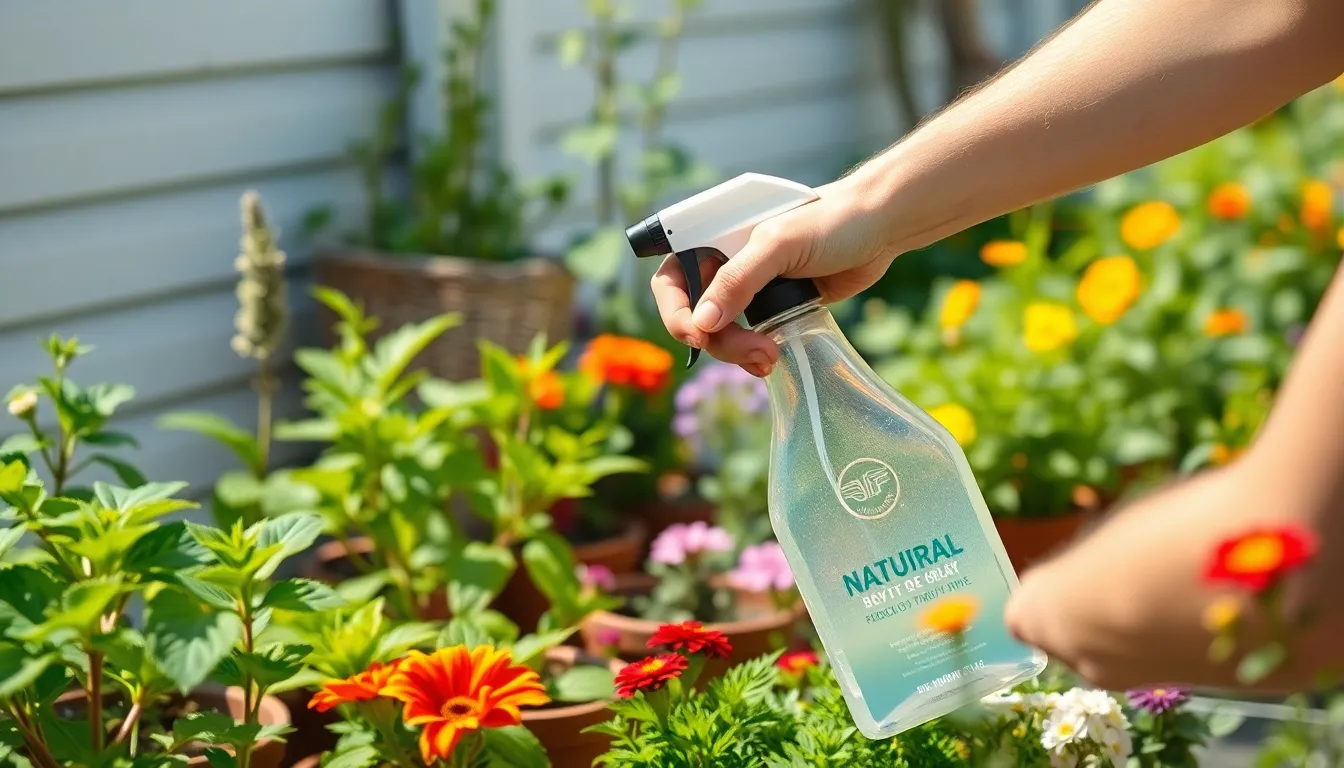
While natural bug sprays offer safer alternatives to chemical pesticides, we must still exercise caution to protect our plants and garden network. Even organic ingredients can cause plant stress or damage when applied incorrectly or to sensitive species.
Testing Sprays on Small Plant Areas
Always test natural bug sprays on a small section of your plant before full application. This simple step prevents widespread damage and helps you identify any adverse reactions. Apply the spray to just a few leaves on one branch and wait 24 hours to observe the plant’s response.
Check for signs of leaf burn, discoloration, or wilting during this observation period. Neem oil root soak treatments particularly benefit from this testing approach, as different plants absorb the oil at varying rates. Document which plants respond well to exact spray formulations for future reference.
Repeat the test process with each new recipe or when treating unfamiliar plant varieties. Plants that show no negative effects after 24 hours are generally safe for broader treatment applications.
Plants That May Be Sensitive to Natural Sprays
Young seedlings and tender foliage plants require extra caution when applying natural bug sprays. Delicate leaves can suffer burn damage from essential oils or concentrated soap answers that mature plants easily tolerate. Herbs with soft leaves often show sensitivity to oil based treatments.
Avoid applying tomato leaf spray to non nightshade plants, as the natural alkaloids may cause adverse reactions. Plants with waxy or fuzzy leaf surfaces may trap spray residues and develop spotting or discoloration. Newly transplanted or stressed plants should receive diluted treatments until they establish stronger root systems.
Monitor flowering plants carefully, as some natural sprays can affect bloom development or petal quality. Adjust concentration levels based on plant maturity and environmental conditions like temperature and humidity.
Protecting Beneficial Insects
Natural insecticides like neem oil work systemically to target harmful pests while sparing beneficial insects. These treatments affect only insects that actually feed on treated plants rather than those making casual contact. Beneficial insects such as bees, ladybugs, and predatory mites remain largely unharmed by properly applied natural sprays.
Essential oils including peppermint and citronella deter exact pest species without broadly eliminating helpful garden allies. Apply sprays during evening hours when beneficial insects are less active to minimize any potential contact. Target application zones carefully to avoid flowers and areas where pollinators frequently visit.
Maintain diverse plantings that support beneficial insect populations alongside your pest control efforts. Balance is key to creating a thriving garden network where natural predators help manage pest populations long term.
Storage and Shelf Life of Natural Bug Sprays
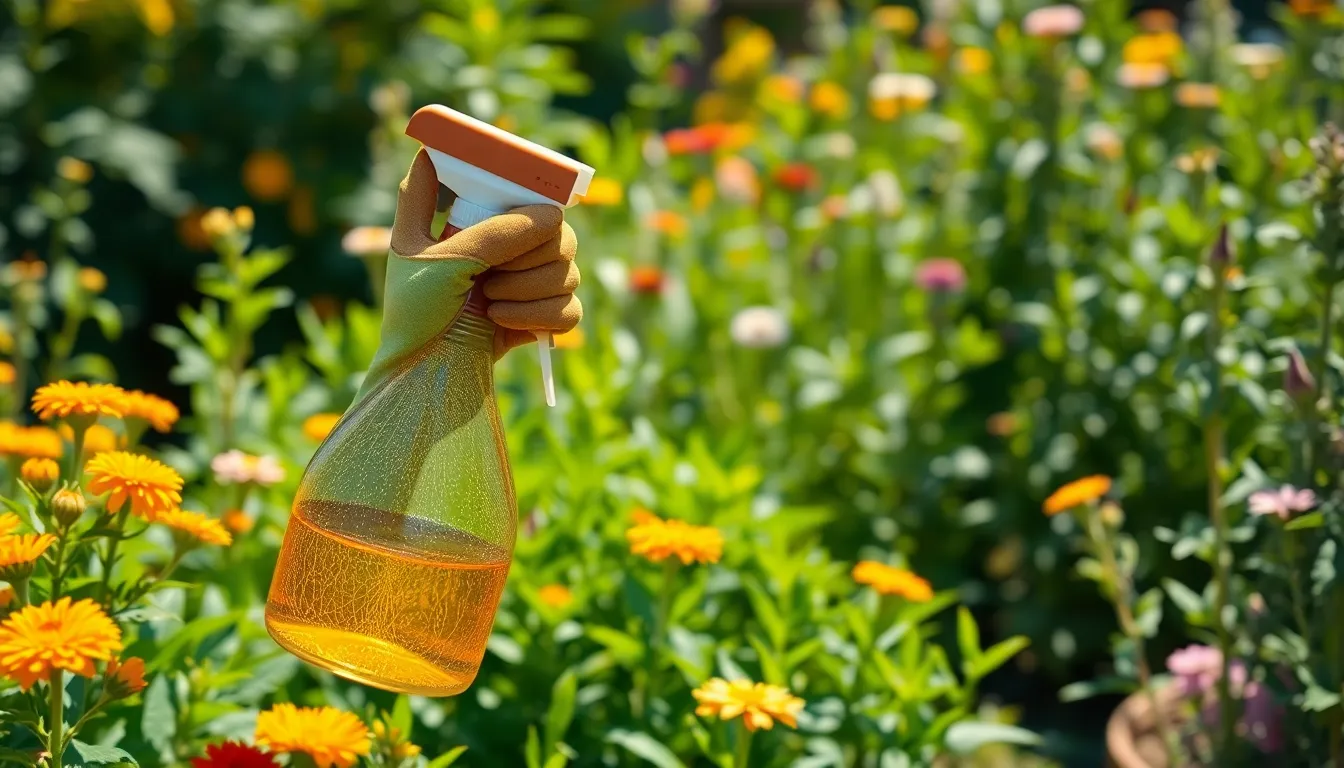
Once we’ve prepared our natural bug sprays, proper storage becomes crucial for maintaining their effectiveness and ensuring they remain safe for our plants.
Proper Storage Techniques
Store natural bug sprays in dry locations away from temperature extremes to preserve their potency and prevent container damage. We should avoid exposing our sprays to freezing conditions below 40°F (4°C) or excessive heat above 100°F, as these temperatures can degrade the active ingredients or cause containers to crack.
Keep sprays in their original, tightly sealed containers to prevent evaporation and contamination that could compromise their effectiveness. Always store containers away from direct sunlight, which can break down natural ingredients and reduce the spray’s pest-fighting power.
Label each container with the preparation or purchase date to track their age and ensure we use older batches first. This simple practice helps us maintain an organized storage system and prevents accidentally using expired products on our plants.
Signs of Spray Deterioration
Watch for ingredient separation or sludge formation in liquid sprays as clear indicators that the product has deteriorated beyond safe use. Clumping or hardening in powder-based sprays also signals breakdown, making proper mixing impossible and reducing effectiveness.
Check spray nozzles regularly for clogging, especially in aerosol containers, which often indicates ingredient degradation or contamination. Changes in color, odor, or texture from the original formulation should prompt immediate disposal rather than risking plant damage.
Discard any spray showing these deterioration signs instead of attempting to use compromised products that could harm our plants or provide inadequate pest control.
Batch Size Recommendations
Prepare or purchase natural bug sprays in quantities we can use within one growing season to maximize freshness and effectiveness. Most natural sprays should be consumed within one to two years at most, unlike synthetic pesticides that typically last 2 to 3 years under proper storage.
Mix smaller batches aligned with seasonal needs to reduce waste and ensure we’re always using potent, fresh ingredients. Natural components degrade faster than synthetic chemicals, making frequent preparation more beneficial than long-term storage.
Rotate our spray inventory by using oldest products first to maintain consistent pest control effectiveness throughout the growing season. This approach prevents accumulation of expired products and ensures our plants receive the most potent natural protection available.
Conclusion
We’ve explored many natural bug spray options that offer effective pest control without compromising our garden’s health or our family’s safety. These homemade answers prove that we don’t need harsh chemicals to maintain thriving plants.
From essential oils to kitchen ingredients like garlic and baking soda we have countless options at our fingertips. Each recipe provides targeted pest control while supporting beneficial insects and maintaining ecological balance.
The key to success lies in proper application timing regular monitoring and combining multiple natural approaches. By following the safety guidelines and storage recommendations we’ve outlined you’ll maximize effectiveness while protecting your plants.
Natural pest control isn’t just about today’s garden—it’s an investment in sustainable gardening practices that benefit our environment for years to come. Start with one or two recipes that appeal to you and gradually build your natural pest management toolkit.
Frequently Asked Questions
What are natural bug sprays and how do they work?
Natural bug sprays are eco-friendly pest control solutions made from common household ingredients like soap, essential oils, vinegar, and herbs. They work by disrupting pests’ sensory receptors, damaging their cell membranes, or creating barriers that repel insects. Unlike chemical pesticides, these natural alternatives break down quickly without harming beneficial insects or leaving toxic residues in your garden.
Are natural bug sprays safe for my family and pets?
Yes, natural bug sprays are much safer than commercial pesticides for families and pets. Made from household ingredients like dish soap, essential oils, and kitchen herbs, they pose minimal health risks when used properly. However, always test sprays on small plant areas first and avoid applying when children or pets are present until the spray has dried.
How much do natural bug sprays cost compared to commercial pesticides?
Natural bug sprays are incredibly cost-effective, often costing under $2 per gallon to make at home. This is significantly cheaper than commercial organic pesticides. The ingredients serve multiple household purposes, making them even more economical over time. You can create effective pest control solutions using items you likely already have in your kitchen.
Which pests can natural bug sprays effectively control?
Natural bug sprays effectively control soft-bodied insects like aphids, spider mites, and whiteflies. Soap-based sprays disrupt their cell membranes, while essential oil sprays repel mosquitoes, ants, and various garden pests. Hot pepper and garlic sprays work well against larger pests like caterpillars. Early intervention is key for maximum effectiveness.
How often should I apply natural bug sprays to my plants?
Apply natural bug sprays every 7-10 days during active pest seasons, or more frequently during heavy infestations. Weather conditions affect application frequency – reapply after rain or heavy watering. For prevention, weekly applications are usually sufficient. Always apply in the evening or on cloudy days to prevent leaf burn and ensure better absorption.
Can natural bug sprays harm my plants?
When properly diluted and applied correctly, natural bug sprays are generally safe for plants. However, always test on a small area first, especially with sensitive plants like young seedlings or delicate foliage. Avoid applying during hot, sunny conditions to prevent leaf burn. Monitor plants for 24-48 hours after application for any adverse reactions.
How long do homemade natural bug sprays last?
Most homemade natural bug sprays last 1-2 weeks when stored properly in cool, dry places away from direct sunlight. Oil-based sprays may separate and need remixing before use. Always label containers with preparation dates and discard any sprays showing signs of spoilage, unusual odors, or mold growth. Prepare smaller batches for optimal freshness.
Do natural bug sprays protect beneficial insects?
Yes, natural bug sprays are designed to target harmful pests while preserving beneficial insects like bees, ladybugs, and butterflies. Unlike chemical pesticides that kill indiscriminately, natural sprays can be applied selectively. Apply in the evening when beneficial insects are less active, and avoid spraying directly on flowers to protect pollinators.
What’s the best time to apply natural bug sprays?
The best time to apply natural bug sprays is in the evening or on cloudy days when temperatures are cooler. This prevents leaf burn and ensures better absorption while protecting beneficial insects that are less active during these times. Avoid applying during the heat of the day or when rain is expected within 24 hours.
Can I combine different natural ingredients in one spray?
Yes, you can combine different natural ingredients to create more potent bug sprays. Popular combinations include garlic and onion, essential oils with soap, or herbs with vinegar. However, always test combinations on small plant areas first and research ingredient compatibility. Some combinations may be too strong for sensitive plants or may not mix well together.





